Catalytic co-pyrolysis of walnut shell and high-density polyethylene (HDPE) using nickel-doped gamma alumina spent adsorbent derived catalyst: Kinetics, thermodynamic and prediction modelling using artificial neural network (ANN) approach
IF 5.2
2区 化学
Q1 CHEMISTRY, APPLIED
引用次数: 0
Abstract
The present study is focused on evaluating the catalytic effect of nickel impregnated spent aluminium hydroxide nanoparticle (AHNP) adsorbent-based catalyst in the co-pyrolysis of walnut shell and high-density polyethylene (HDPE). The analysis was conducted through kinetic and thermodynamic assessments. Specific kinetic parameters, such as activation energy and pre-exponential factor, along with thermodynamic parameters, including entropy, enthalpy, and Gibbs free energy, was estimated using iso-conversional models such as Ozawa Flynn Wall (OFW), Kissinger Akahira Sunose (KAS) and Starink model. Thermogravimetric analysis of pyrolysis of walnut shell, HDPE, blend of walnut shell and HDPE (1:1) and blend of feedstock with catalyst (1:1) was conducted at different heating rates of 10–40 °C/min respectively. The results showed that the incorporation of nickel doped gamma alumina (NAO) catalyst lowered the activation energy (Ea) of co-pyrolysis of walnut shell and HDPE by 28 % as calculated by KAS method. Moreover, artificial neural network (ANN) was also applied for the predictive modelling of the degradation of walnut shell and HDPE where high regression (R≈0.99) as well as low mean squared error (<10−5) illustrated the accurate prediction of complex biomass and plastics degradation by the ANN model. Therefore, catalyst derived from waste AHNP has considerable potential to be utilized for the co-pyrolysis of biomass with plastics, enhancing the process's cost effectiveness, environmental sustainability, and renewability.
利用掺杂镍的γ氧化铝废吸附剂衍生催化剂催化核桃壳和高密度聚乙烯(HDPE)共热解:动力学、热力学和基于人工神经网络(ANN)方法的预测建模
研究了镍浸渍废氢氧化铝纳米颗粒(AHNP)吸附基催化剂对核桃壳和高密度聚乙烯(HDPE)共热解的催化作用。分析是通过动力学和热力学评估进行的。具体的动力学参数,如活化能和指数前因子,以及热力学参数,包括熵、焓和吉布斯自由能,使用Ozawa Flynn Wall (OFW)、Kissinger Akahira Sunose (KAS)和Starink模型等转换模型进行估计。在10 ~ 40℃/min不同升温速率下,分别对核桃壳、HDPE、核桃壳与HDPE共混(1:1)、原料与催化剂共混(1:1)的热解过程进行热重分析。结果表明,经KAS法计算,掺杂镍的γ -氧化铝(NAO)催化剂使核桃壳与HDPE共热解的活化能(Ea)降低了28% %。此外,人工神经网络(ANN)也被应用于核桃壳和HDPE降解的预测建模,其中高回归(R≈0.99)和低均方误差(<10−5)说明了ANN模型对复杂生物质和塑料降解的准确预测。因此,从废弃AHNP中提取的催化剂具有相当大的潜力,可以用于生物质与塑料的共热解,从而提高该过程的成本效益、环境可持续性和可再生性。
本文章由计算机程序翻译,如有差异,请以英文原文为准。
求助全文
约1分钟内获得全文
求助全文
来源期刊

Catalysis Today
化学-工程:化工
CiteScore
11.50
自引率
3.80%
发文量
573
审稿时长
2.9 months
期刊介绍:
Catalysis Today focuses on the rapid publication of original invited papers devoted to currently important topics in catalysis and related subjects. The journal only publishes special issues (Proposing a Catalysis Today Special Issue), each of which is supervised by Guest Editors who recruit individual papers and oversee the peer review process. Catalysis Today offers researchers in the field of catalysis in-depth overviews of topical issues.
Both fundamental and applied aspects of catalysis are covered. Subjects such as catalysis of immobilized organometallic and biocatalytic systems are welcome. Subjects related to catalysis such as experimental techniques, adsorption, process technology, synthesis, in situ characterization, computational, theoretical modeling, imaging and others are included if there is a clear relationship to catalysis.
 求助内容:
求助内容: 应助结果提醒方式:
应助结果提醒方式:


